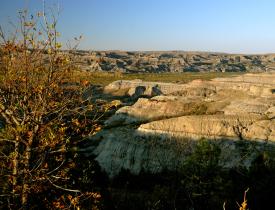Celebrate Life with North Dakota Powwows
Dancers and colorful regalia add to the tradition's beauty.
Powwows are a celebration of life and multiple cultures within Native American culture. They are a beautiful event involving many different styles, dances and songs. The Algonquin word "pau wau" was the Native American word some of the first Europeans associated with dancing. Although pau wau meant "he dreams" to the Algonquins, the term was eventually accepted by the Europeans to refer to dancing, later being spelled "powwow."
Powwows were originally held in the springtime to celebrate the beginning of new life, but are now held throughout the year. The celebrations often have religious significance, but are also a time for people to gather, sing, dance, feast, pray, renew old friendships and make new ones. These celebrations are still an important part of life for many Native American.
The Grand Entry opens the parade of dancers and is a time for contestants to score points by displaying their style and regalia. Dancers always enter the arbor and dance sun-wise, or clockwise, around an eagle staff. Following you can learn more about what each dance represents and how to identify it. Please keep in mind these descriptions are brief and non-specific. Styles and beliefs vary from tribe to tribe and area to area.
Men’s Traditional Dancer
This style of dance portrays the excitement of a battle or hunt. Dancers will crouch low to reenact the approach of a target followed by standing up with energetic and fast movements depicting the attach. They will not dance backwards since that can signify retreat. Regalia includes beads, quillwork and circular bustles of eagle feathers in honor of their connection to nature.
Men’s Grass Dance
This dance is typically a bit faster than traditional and includes repetitive and symmetrical movements from one side of the body to the next. This style of dance depicts a time of prairie tribes living on uncultivated lands where tall grass inhibited dance steps. The dancers' feet pushing into the ground symbolizes stomping down these grasses. They are often adorned in feathers, long pieces of fabric and fringes that sway to the beat of the dance.
Men’s Fancy Dance
Men’s Fancy is a fast and acrobatic dance that is typically performed by men and young boys. Steps are fast, athletic and keep to the beat of the drum while spinning. Dancers often come to a complete stop at the last beat of the song with a strong pose. Regalia includes bright neon colors, bustles and full-beaded accessories.
Northern Plains Women’s Traditional Dance
This style of dance is graceful and melodic. Dancers move in multiple ways, whether back and forth or in a circle around the arena, but in a consistent bouncing movement. The feet must not leave the ground, symbolizing the woman’s connection with mother earth. Some traditions say this movement symbolizes a woman watching her warrior come home. Regalia includes long skirts or dresses made of buck skin adorned with bone and teeth.
Women’s Fancy Shawl Dance
This style of dance is very similar to Men’s Fancy. Dancers wear brightly colored clothing with long fringes, but emphasis is put on the shawl. These shawls include elaborate designs, ribbon work and applique. As the dancers spin and jump to the beat of the music, the bright colors and fabrics beautifully flow around the arena. This dance is often compared to a butterfly in flight.
Jingle Dress Dance
This style is easily recognizable by the many rows of jingling metal cones along the dancer’s dress. Some dresses can include hundreds of them. The style is described as elegant and graceful. Dancers can cross their feet, dance backwards and complete full circles. Some believe this dance brings good health and helps cure sickness. A more modern day take believes this dance speaks to the power of women.
Men's Chicken Dance
The Men's Chicken Dance Style originates amongst the Blackfoot people. The story of the chicken dance includes a young Blackfoot man hunting shooting prairie chickens with his bow and arrow to feed his family. When the man fell asleep, the prairie chicken spirit asked him, "Why did you kill me? My people were doing a sacred dance of my people". The man replied that he needed to feed his family. The prairie chicken had honored this and told this man that he was going to teach him the sacred dance of his people. He was to go out there and teach every man this dance and if he did not do as he was told this prairie chicken was going to come back and take this man's life. This is how the Prairie Chicken Society and Men's Chicken Dance came to the Blackfoot people.
Powwow Drum Circles and Singing
Drum circles and singers are a group that garner great respect. They are typically a circle of five or more men, each pounding to the beat on one main drum in the center. In these circles, there is typically a head singer. He will lead the circle in song, beat and can designate other singers as he wishes. The rhythms and songs they play represent the heartbeat of Mother Earth and bring all those in attendance at a powwow or in the vicinity of the circle together.
Click here for information on powwow etiquette
Click here for a list of North Dakota rodeos and powwows






